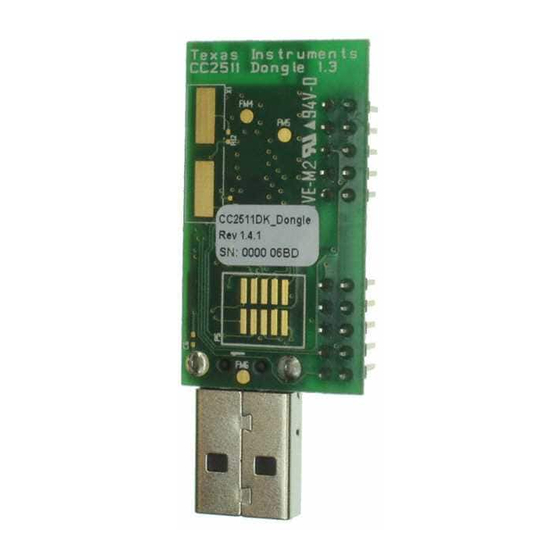
Texas Instruments CC2511 Quick Start Manual
Usb evaluation kit
Hide thumbs
Also See for CC2511:
- User manual (24 pages) ,
- User manual (13 pages) ,
- Quick start instructions (3 pages)
Advertisement
Quick Links
CC2511 USB Evaluation Kit Quick Start Guide
1. Kit Contents
1 x CC2511 USB Dongle
This Quick Start Guide
The hardware in this kit is FCC and IC certified
and complies with ETSI/R&TTE requirements
over temperature from 0 to +35°C.
FCC/IC Regulatory Compliance
FCC Part 15 Class A Compliant
IC ICES-003 Class A Compliant
4. Programming the Dongle
For the USB dongle to operate as a
packet capture device, it must be
programmed with the packet sniffer
firmware. By default, the dongle comes
pre-programmed with this firmware.
Connect the USB dongle to the
debugger or the development board
with an appropriate 10 pin flat cable.
The dongle must also be powered via
the USB bus. Refer to picture below
for an example.
Caution! Avoid using other power
1
sources
for the dongle than a regular
USB voltage source at max 5.5V, 500
mA, (efficiency level V).
1
When using an external power supply, make sure it meets the listed requirements in addition to complying with
applicable regional product regulatory and safety certification requirements such as UL, CSA, VDE, CCC, and PSE.
2. Getting Started
The CC2511 USB Dongle can be
used as a development platform for
USB and RF applications.
An external development board or
debugger, like the CC Debugger,
SmartRF04EB or SmartRF05EB, is
required to program and debug
software running on the CC2511.
Note that the CC2511 USB Dongle is
pre-programmed with
sniffer firmware.
This
Quick
Start
describe how to use the dongle
with the packet sniffer and what
would be the next steps for
developing your own software.
5. Programming the Dongle
Launch
the
SmartRF
Programmer and make sure you
select the "System-on-Chip" tab. The
tool should show a line with CC2511
connected to a SmartRF04EB.
Next, locate the flash image
sniffer_fw_ccxx11.hex in
"C:\Program Files\Texas Instruments\SmartRF
Tools\Packet Sniffer\bin\general\firmware"
Select "Erase, program and verify"
and press the "Perform Actions"
button.
3. Preparations
Before
download and install the following
tools:
SmartRF Flash Programmer
www.ti.com/tool/flash-programmer
You will need this tool to program
the packet capture firmware on the
CC2511 USB dongle
SmartRF Packet Sniffer
the packet
www.ti.com/packetsniffer
This is the PC tool that displays
Guide
will
and parses the packets received by
the capture device.
6. Install USB Driver
Flash
After
programming
disconnect the dongle from the
programming board and plug it into
the PC. Windows' new hardware
wizard will appear.
Select the options for automatic
installation and wait for the driver
installation to complete. If the
Wizard asks for a specific driver,
point it to the cebal2.inf file located
in
"C:\Program Files\Texas Instruments\SmartRF
Tools\Drivers\cebal\win_<arch-specific>\"
After installation of the driver, the
Packet Sniffer capture device is
ready for use.
September 2013
proceeding,
please
the
device,
Advertisement

Summary of Contents for Texas Instruments CC2511
- Page 1 September 2013 CC2511 USB Evaluation Kit Quick Start Guide 1. Kit Contents 2. Getting Started 3. Preparations The CC2511 USB Dongle can be Before proceeding, please used as a development platform for download and install the following USB and RF applications.
- Page 2 The CC2511 capture device can be on the device are set according to the packets. used with the SimpliciTI or the Generic format of the radio signals you are (no parsing) protocols.
-
Page 3: Regulatory Compliance Information
Any exceptions to this are strictly prohibited and unauthorized by Texas Instruments unless user has obtained appropriate experimental/development licenses from local regulatory authorities, which is responsibility of user including its acceptable authorization. - Page 4 FCC Interference Statement for Class B EVM devices This equipment has been tested and found to comply with the limits for a Class B digital device, pursuant to part 15 of the FCC Rules. These limits are designed to provide reasonable protection against harmful interference in a residential installation. This equipment generates, uses and can radiate radio frequency energy and, if not installed and used in accordance with the instructions, may cause harmful interference to radio communications.
- Page 5 Also, please do not transfer this product, unless you give the same notice above to the transferee. Please note that if you could not follow the instructions above, you will be subject to penalties of Radio Law of Japan. Texas Instruments Japan Limited (address) 24-1, Nishi-Shinjuku 6 chome, Shinjuku-ku, Tokyo, Japan http://www.tij.co.jp...
- Page 6 FDA Class III or similar classification, then you must specifically notify TI of such intent and enter into a separate Assurance and Indemnity Agreement. Mailing Address: Texas Instruments, Post Office Box 655303, Dallas, Texas 75265 Copyright © 2013, Texas Instruments Incorporated...














Need help?
Do you have a question about the CC2511 and is the answer not in the manual?
Questions and answers